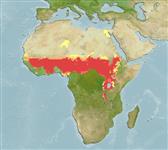Actinopterígios (peces con aletas radiadas) >
Perciformes (Perch-likes) >
Cichlidae (Cichlids) > Pseudocrenilabrinae
Etymology: Oreochromis: Latin, aurum = gold + Greek, chromis = a fish, perhaps a perch (Ref. 45335); niloticus: From "Filhoa" = the Amharic word for "hot spring" (Ref. 2).
Medioambiente / Clima / Gama
Ecología
; agua dulce; salobre bentopelágico; potamodromo (Ref. 51243); rango de profundidad 0 - 20 m (Ref. 32849), usually ? - 20 m (Ref. 34290). Tropical; 14°C - 33°C (Ref. 3), preferred ?; 32°N - 5°S, 17°W - 38°E
Africa: naturally occurring in coastal rivers of Israel (Ref. 5166), Nile basin (including lake Albert, Edward and Tana), Jebel Marra, Lake Kivu, Lake Tanganyika, Awash River, various Ethiopian lakes, Omo River system, Lake Turkana, Suguta River and Lake Baringo (Ref. 2). In West Africa natural distribution covers the basins of the Senegal, Gambia, Volta, Niger, Benue and Chad, with introduced specimens reported from various coastal basins (Ref. 53405). Widely introduced for aquaculture, with many existing strains. Several countries report adverse ecological impact after introduction. The following subspecies were previously recognized: Oreochromis niloticus baringoensis, Oreochromis niloticus cancellatus, Oreochromis niloticus eduardianus, Oreochromis niloticus filoa, Oreochromis niloticus niloticus, Oreochromis niloticus sugutae, Oreohromis niloticus tana and Oreohromis niloticus vulcani.
Length at first maturity / Tamaño / Peso / Age
Maturity: Lm 18.6, range 6 - 28 cm
Max length : 60.0 cm SL macho / no sexado; (Ref. 4967); peso máximo publicado: 4.3 kg (Ref. 40637); edad máxima reportada: 9 años (Ref. 164)
Espinas dorsales (total): 15 - 18; Radios blandos dorsales (total): 11-13; Espinas anales 3; Radios blandos anales: 9 - 11; Vértebra: 30 - 32. Diagnosis: jaws of mature male not greatly enlarged (length of lower jaw 29-37 % of head length); genital papilla of breeding male not tassellated (Ref. 2). Most distinguishing characteristic is the presence of regular vertical stripes throughout depth of caudal fin (Ref. 4967, 53405).
Occur in a wide variety of freshwater habitats like rivers, lakes, sewage canals and irrigation channels (Ref. 28714). Mainly diurnal. Feed mainly on phytoplankton or benthic algae. Oviparous (Ref. 205). Mouthbrooding by females (Ref. 2). Extended temperature range 8-42 °C, natural temperature range 13.5 - 33 °C (Ref. 3). Maximum depth from Ref. 34290. Marketed fresh and frozen (Ref. 9987).
Sexual maturity is reached at 3-6 months depending on temperature, reaching about 30 g. Reproduction occurs only when temperatures are over 20°C. Several yearly spawnings every 30 days. Females incubate eggs inside their mouths (approximately for a week) where larvae hatch and remain until the vitellus is reabsorved. Egg size 1.5 mm, larval length at hatching 4 mm.
Spawns in firm sand in water from 0.6 to 2 m deep of lakes (Ref. 2) and inshore waters (Ref. 55624). Males set up and defend territory which are visited by the females. Courtship lasts several hours. A single male probably fertilises the eggs of more than one female (Ref. 55624). Eggs are shed in batches in shallow nest and fertilized by male. Each batch of eggs is picked up into oral cavity by female. Females solely involved in broodcare. Female carries up to 200 eggs in her mouth where the larvae hatch and remain until after the yolk-sac is absorbed.
Trewavas, E., 1983. Tilapiine fishes of the genera Sarotherodon, Oreochromis and Danakilia. British Mus. Nat. Hist., London, UK. 583 p. (Ref. 2)
IUCN Red List Status (Ref. 115185)
CITES (Ref. 94142)
Not Evaluated
Threat to humans
Potential pest
Human uses
Pesquerías: muy comercial; Acuicultura: comercial
Herramientas
Special reports
Download XML
Fuentes de Internet
